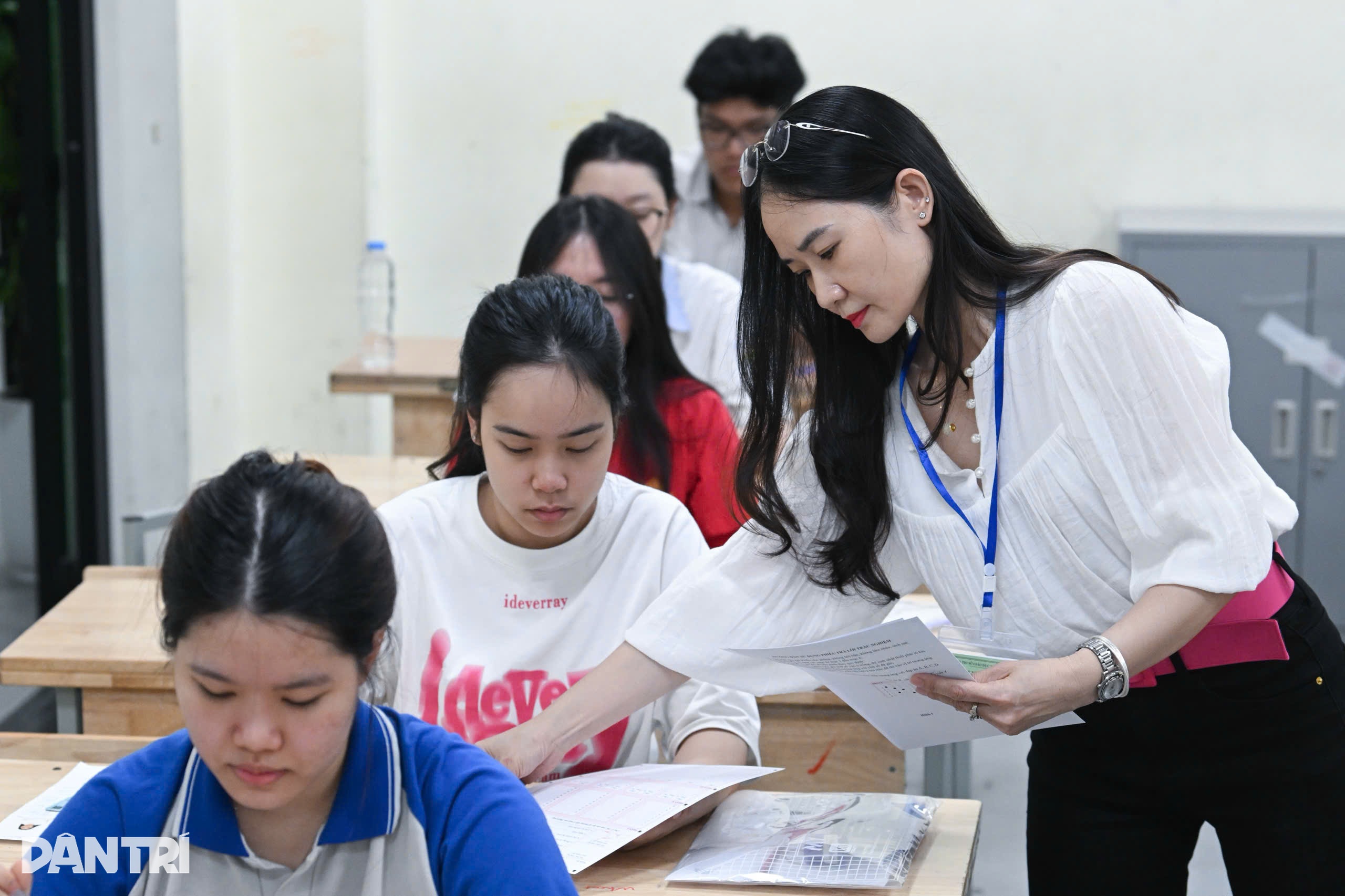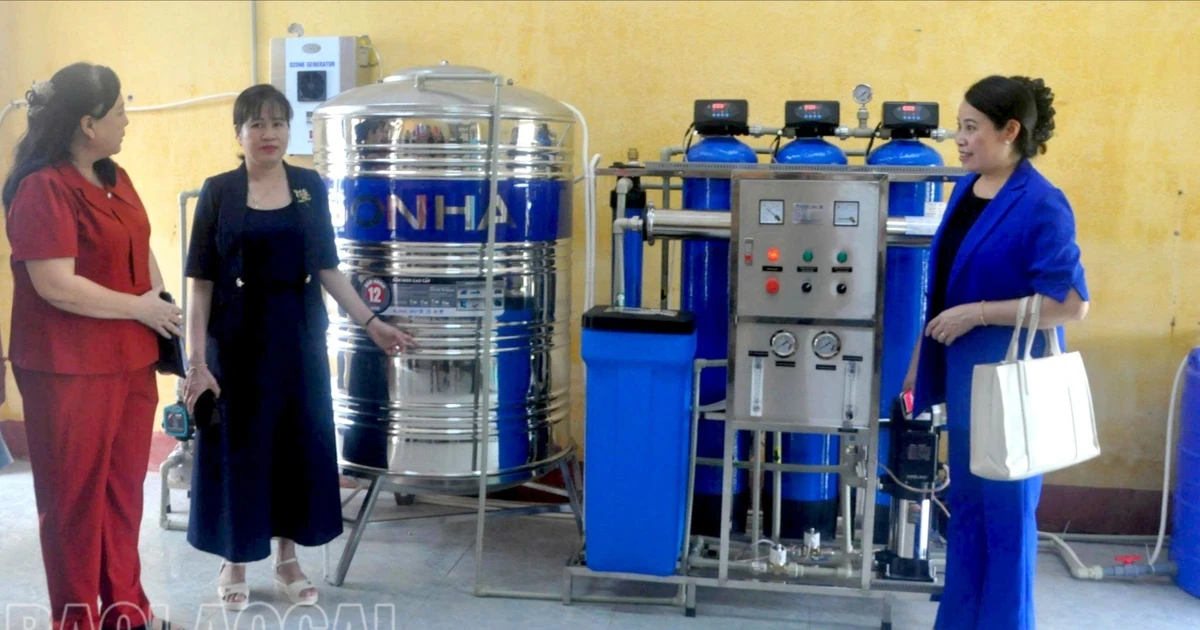Editor's note:
The 2025 high school graduation exam marks an important milestone in the implementation of the 2018 general education program. The Ministry of Education and Training has set three goals for this exam: to assess learners' learning outcomes according to the goals and standards of the new program; to use exam results to consider recognizing high school graduation and to serve as one of the bases for assessing the quality of teaching and learning of general education institutions and the direction of education management agencies; to provide reliable data for universities and vocational education institutions to use in enrollment in the spirit of autonomy.
On that basis, the Ministry has made strong and drastic innovations in both exams and university admission regulations to aim for real learning and real testing, reduce exam pressure, promote the teaching and learning process according to the abilities and interests of each individual, while ensuring fairness and transparency.
However, as these ambitious policies were put into practice, a series of challenges arose.
From English exams with difficulty levels exceeding the standard, the uneven test matrix of each subject, the difference in scores between groups, to the complicated regulations on equivalent score conversion... All of these unintentionally create "privileges" for a group of candidates and widen the gap with candidates in rural and remote areas.
With the series of articles "High school graduation exam and university entrance exam 2025: The maze of innovation and concerns about fairness", we not only look back at the problems that have occurred but also dig deep to find the core causes, thereby proposing solutions and making practical recommendations so that the high school graduation exam and university entrance exam in 2026 and the following years will truly be a fair and transparent competition for each learner and each training institution, while also positively impacting innovation in teaching and learning at the high school level.
At the end of November 2024, the draft amendment and supplement to the 2025 University Admissions Regulations of the Ministry of Education and Training (MOET) attracted great public attention when it first introduced a requirement to convert equivalent admission scores.
Accordingly, all admission methods in the same industry will have to be converted to a common scale and considered from high to low, without dividing the quota for each method as before.
In March 2025, the new regulations were officially issued. Eliminating 100% of early admissions, eliminating the division of quotas according to each admission method, and converting the equivalent admission score between methods to 3 new points will completely change the university admission picture in 2025.
Explaining the regulation on converting equivalent scores, the Ministry of Education and Training affirmed that this is to protect the fairness, transparency and quality of the admission system.
In fact, the old admission method has many loopholes. When free schools divide their quotas for each method, the situation of exploiting the quotas for negative admissions is very likely to occur.
For example, major A has 100 quotas, the school divides 50 quotas for the graduation exam method and 50 quotas for the high school transcript + IELTS method. But when considering admission, the school arbitrarily calls for 70 quotas for considering high school transcript + IELTS and only 30 quotas for graduation consideration, leading to a group of candidates with low graduation scores but being admitted based on high school transcripts. And conversely, a group of candidates with higher graduation scores but failed because of the "squeezed" quota.
In this case, eliminating the method of dividing the quota and converting equivalent scores will bring everything to a common scale, thereby plugging the negative loopholes and creating fairness for all candidates.
The Ministry does not impose a general conversion formula but only provides a general conversion framework to avoid the situation where each place has its own way, causing chaos in the admission system, while respecting the autonomy of schools.

Candidates taking the 2025 high school graduation exam (Photo: Trinh Nguyen).
At the time of issuing the regulations, sharing with the press, the Ministry's leaders had anticipated that each school would convert differently for specific reasons, but the conversion framework would be the standard so that the difference would not be too different, and at the same time have a clear scientific basis.
But in reality, the Ministry's conversion framework creates many loopholes for schools to "dodge".
“Each tree has its own flower, each family has its own… percentile”
The technique for equivalent conversion according to the general conversion framework of the Ministry of Education and Training is the percentile method. This method is a statistical technique to compare the relative position of candidates in each score spectrum.
Accordingly, schools will analyze the score data of all candidates in different exams, determine the percentile for each score level. The next step is to build a conversion table, in which scores at the same percentile will be considered equivalent.
For example, if the top 5% of block A00 in the high school exam is 28 points, and the top 5% in the competency assessment exam (HSA) is 120 points, then 28 is equivalent to 120.
When a conversion table is available, the linear interpolation formula is applied to calculate equivalent scores for scores within each score range. This formula helps convert the admission score of one admission method to the scale score of another admission method.
This seemingly simple method has caused confusion and disarray for both students and parents. One of the psychological barriers is that the concept of “percentile” is too unfamiliar, heard for the first time by many people.
MSc. Pham Thai Son, in charge of admissions at Ho Chi Minh City University of Industry and Trade, said the concept of percentile is not only unpopular with candidates but also with admissions experts.

The concept of percentile is not only unpopular with candidates but also with admissions experts (Illustration: Manh Quan)
But the more important reason is the "chaos" of percentiles. With the same score of the ability assessment or thinking assessment (TSA), each candidate has a different equivalent conversion score without understanding why it is different.
For example, a candidate with 70 TSA points converted to 27.56 points at Hanoi University of Science and Technology, is calculated as 27.75 points at Hanoi University of Industry, but only gets 26 points at National Economics University.
Similarly, with the same HSA score of 121, the candidate was given 29.52 at Hanoi National University, but only 27.25 at Hanoi University of Industry.
The difference in converted scores between schools ranges from 1 to 2.5 points, which is too large. Meanwhile, schools do not give convincing explanations for their conversion formula. Each school determines the percentile differently even though they have the same admission methods.
Foreign Trade University mechanically converts methods to a 30-point scale, then determines the equivalent score range. For each training program, the school has a different percentile table, forcing students to really “brainstorm” to calculate their scores.
National Economics University has another creative approach: calculating bonus points for admission for each method with special priority for candidates with IELTS certificates, then building a conversion table.
Specifically, the school adds 0.75 points to all candidates with international English certificates, regardless of high or low scores. For example, candidates with IELTS 5.5 or 9.0 will all receive the same 0.75 points.
At the same time, the school calculates the converted score to a 10-point scale for the English certificate. A minimum of 5.5 IELTS is counted as 8 points; 6.5 IELTS is counted as 9 points; from 7.5 IELTS and above is counted as 10 points.
Thus, if the candidate has a graduation exam result of 8 points in math, 8 points in physics, IELTS 6.5, the admission score will be: (8+8+9+0.75) = 25.75 (points).
Meanwhile, another candidate got 8 points in math, 8 points in physics and 9 points in English but did not have IELTS so only got 25 points.
With the above method of calculating admission scores, no matter what formula is used to convert equivalent scores, candidates who have IELTS combined with admission are still far ahead of candidates who only have pure high school graduation exam scores.
The Ministry of Education and Training's goal of fairness in eliminating early admission and dividing quotas according to each method becomes meaningless if schools still hold the trump card of applying a high coefficient to the admission score for the "favorite" method before conversion.
And then the chaos becomes difficult to control.



In principle, there are four main bases for schools to determine percentiles and convert equivalent scores. One is the score distribution of exams; two is admission data from previous years; three is the learning outcomes of students admitted by different methods; four is the characteristics of each major and each school.
When explaining the reason for “adding points twice for candidates with IELTS”, the National Economics University cited the academic results of students for 3 consecutive years and affirmed that candidates admitted with HSA + IELTS scores had better academic results than candidates admitted by other methods.
However, the reliability of the above information has no public data for public verification. The scientific basis of the equivalent conversion formulas at universities is still "vague".
"Noisy" input, is the percentile still accurate?
At the time when the regulations on equivalent score conversion were still being drafted, many experts expressed concern about the impossibility of calculating "equivalence" when admission methods used different scales, not the story of the scale.
The scales of the aptitude test and the thinking test are completely different. While the TSA assesses thinking ability and the ability to apply knowledge to solve problems in the field of mathematics and natural sciences, the HSA comprehensively assesses students in both quantitative and qualitative thinking.
HSA and TSA are even more different from the graduation exam scale - an exam with the important task of assessing the output of the general education program in addition to the goal of classifying candidates for university admission.
When the scale of measurement is different, the equivalent point conversion cannot guarantee equivalence. Just like in mathematics, we cannot exchange two numbers when they do not have the same unit of measurement.
However, the Ministry of Education and Training's view is that if a major has multiple admission methods, those methods must be equivalent in terms of the level of assessment of candidates' abilities. When the assessment level is equivalent, it must be converted to an equivalent benchmark score.
On the contrary, if the benchmark scores cannot be converted because they are not on the same assessment scale, they cannot be used to consider admission to the same major.
This is entirely true, but only in the absence of confounding factors.
Meanwhile, in the 2025 high school graduation exam, there are many input interference factors that make the equivalence conversion inappropriate.

Parents wait for their children after the final exam of the 2025 high school graduation exam (Photo: Phuong Quyen).
The first factor is the unevenness between the exam matrices of the subjects, making some subjects difficult and some easy, leading to a difference in exam scores between the subject combinations for admission. This year, the disadvantage lies in the combinations of math and English because the exam questions of these two subjects are assessed by many experts as "difficult to exceed the standard".
To convert between methods, schools need to add one more step, which is to convert between combinations. Some schools comply with the Ministry's conversion regulations, some do not. However, the basis for calculating the difference in scores between combinations is once again not fully and scientifically explained.
The second confounding factor is the conversion of international language certificates into foreign language test scores in the admission combination. Here, the equivalence story becomes a hotly debated topic in educational groups.
As mentioned above, this year's English high school graduation exam is considered "difficult to exceed standards", with many reading comprehension questions at levels B2 to C1, while the output standard for high school students is only B1. The number of students who scored 7 or higher is only 15%.
However, if you have an IELTS certificate of 5.0 or higher, you can easily get a perfect 10 when applying to the University of Commerce. If you have an IELTS of 6.5, you can get a perfect 10 in English at the University of Science and Technology, the Academy of Finance, Hanoi National University of Education 2 and dozens of other universities.
If candidates apply to the National Economics University, they will immediately receive 0.75 points.
The total number of candidates nationwide who achieved a score of 10 in the English graduation exam is 141. But the number of candidates who achieved a score of 10 in English converted from the IELTS certificate is many times larger.
The IELTS score conversion table to English subject scores has caused inequality between the two groups of candidates. For example, a candidate who scores 7 in math, 8 in physics, 8 in English, and IELTS 6.5 will be counted as 25 points for block A01 (math, physics, English) if he/she registers for the University of Commerce. However, if the candidate does not have IELTS, the admission score is only 23.
The percentiles announced by schools do not distinguish between candidates applying for admission based on pure A01 block scores and A01 block scores with converted English as in the above case.
In other words, the equivalence is not equivalent when the IELTS score conversion table alone does not achieve the necessary equivalence. Each school also has a different IELTS conversion table without explaining the basis for the conversion.
Need a common conversion formula from the Ministry of Education and Training
The 2025 university admission season is the first time that a major university in Ho Chi Minh City has shocked candidates by announcing that it will not apply the Ho Chi Minh City National University's aptitude test scores to 5 majors including applied mathematics, data science, history, geography, and information and library science.
That is the case of Saigon University. The reason the school had to abandon the APT method is because Ho Chi Minh City National University does not convert the capacity assessment scores and graduation exam scores in the A00 (math, physics, chemistry) and C00 (literature, history, geography) groups.
Immediately afterwards, the Center for Testing and Training Quality Assessment of Ho Chi Minh City National University sent this school a percentile table.
After receiving the information, Saigon University quickly “turned around” and announced that it would resume the APT method. The announcement was made on July 28, just a few hours before the Ministry of Education and Training’s application registration system closed.
The confusion of schools in the first admissions season with percentiles is visible.
According to Mr. Pham Thai Son, the equivalent score conversion has some benefits such as creating a common standard for fairer comparison. Candidates from different assessment forms will be placed on the same reference system and help schools easily compare the level of academic ability and capacity between groups of candidates.
In addition, percentiles help make multi-method admissions more transparent when converted to the same scale.



However, Mr. Son said that the disadvantage of this regulation is that there is no unified correlation coefficient between universities. At the same time, not all schools have the technical capacity to perform equivalent score conversion.
From these shortcomings, Mr. Pham Thai Son proposed that the Ministry of Education and Training should have a common conversion formula for universities, to be more objective and fair for all schools. It is possible to use the solution of testing the conversion of a certain university with capacity for a few years, thereby evaluating the effectiveness and collecting feedback before applying it widely.
From another perspective, Dr. Vu Duy Hai - Head of Admissions and Career Guidance Department, Hanoi University of Science and Technology - borrowed the image of converting exchange rates between currencies and the US dollar and commented: "There is no absolutely optimal conversion method, just like the exchange rates of USD or Euro dance up and down. What matters is how schools implement it.
For example, in the past, there were cases where candidates with high scores still failed, and schools recruited more candidates thanks to loosening the early admission criteria... Converting scores by percentiles cannot cause the above situations, because the nature of a unified way of converting scores will be transparent, similar to the common way of converting money on an exchange.
However, when implementing, some schools "dodge" the regulations or cannot implement them, or even implement them unclearly, causing confusion for parents," Associate Professor, Dr. Vu Duy Hai said.
Unlike currency, Mr. Hai said that the reason why the Ministry of Education and Training only issued general regulations and assigned higher education institutions to convert scores is because schools have many different admission methods. In particular, some private schools do not convert due to weak capacity or only consider academic records to "sweep" candidates to meet the quota, so there is a situation where each school converts scores differently.
"If the Ministry of Education and Training is required to come up with a common conversion method for schools to apply, first of all, schools must not have too many admission methods.
If the current situation remains the same, the Ministry of Education and Training will not have enough people and conditions to find correlation points for hundreds of admission methods, including many "odd" methods that schools have proposed.
Therefore, in order to avoid confusion in the conversion as it is now, the Ministry of Education and Training needs to “tighten” the admission methods of schools, each school should only have 2-3 basic admission methods. Thus, the conversions are also simple and easy to understand as Hanoi University of Science and Technology is implementing,” said Mr. Vu Duy Hai.
Also from this perspective, Mr. Dao Tuan Dat, lecturer at Hanoi University of Science and Technology, founder of Einstein High School (Hanoi), said that converting according to percentiles ensures fairness for candidates. Many countries in the world follow this method. Converting according to percentiles will not cause candidates to "fail to pass with high scores".
The point is that because there is no common conversion formula, no school implements it, so it is "confused". For example, through survey statistics, some schools show that some combined methods often have better academic scores, so the school "dodges" the conversion method to "sweep" these candidates, causing unfairness for other candidates.
Therefore, according to Mr. Dat, as a professional manager, the Ministry of Education and Training should have a specific general conversion formula, not letting each school do it their own way. This helps to be fair to candidates because schools cannot circumvent the law.
Source: https://dantri.com.vn/giao-duc/loan-bach-phan-vi-quy-doi-diem-tuong-duong-co-that-su-tuong-duong-20250811010955867.htm
























![[Photo] An Phu intersection project connecting Ho Chi Minh City-Long Thanh-Dau Giay expressway behind schedule](https://vstatic.vietnam.vn/vietnam/resource/IMAGE/2025/8/21/1ad80e9dd8944150bb72e6c49ecc7e08)





































![[Photo] Politburo works with the Standing Committee of Hanoi Party Committee and Ho Chi Minh City Party Committee](https://vstatic.vietnam.vn/vietnam/resource/IMAGE/2025/8/21/4f3460337a6045e7847d50d38704355d)
































Comment (0)